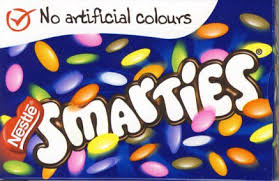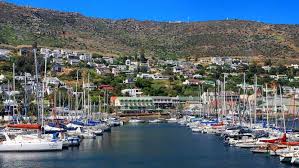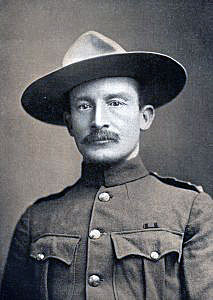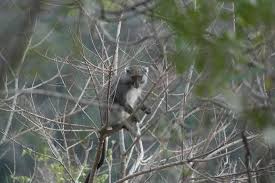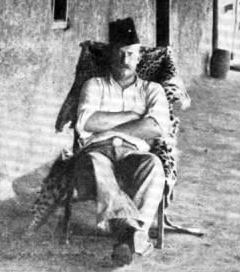I am leaving on the 8th of September destination Kleinsee on the north west coast of South Africa to visit my daughter Susan. Kleinsee is just south of Port Nolloth and Alexander Bay with Namibia just north of these towns. Jack and I will stay at Kuruman on the first night and Pofadder on the next heading towards Springbok deep in Namaqualand. We had good rains this winter in this area so the flowers should be wonderful. Each year they appear, softer colours down south nearer Cape Town and more vibrant colours as one heads north. The floral kingdom of South Africa attracts tourists from all over the world.
My route takes me from Johannesburg via Vryburg, Olifanshoek (elephant corner), Upington to Kuruman. Kuruman is interesting in that it was here that Robert Moffat the missionary translated the Bible into Tswana, a local language and printed it on his own printing press. His daughter Mary married David Livingstone and they left Kuruman to find Ngamiland in Botswana.
They settled at Kolobeng, synonymous with the names of two men, David and Kgosi Sechele. One was a zealous missionary come there to convert the heathen in the name of Christianity and the other the chief of the Bakwena tribe. Their paths were fated to diverge, Livingstone’s to lead him across the face of Darkest Africa and immortality in the annals of history, Sechele’s to l embrace a strange religion and begin to lead his people into the changing world which the coming of the white man brought to Africa.

Livingstone and his wife Mary and their children arrived in 1847. He built a house there erroneously believing that the Kolobeng River would be a constant source of water. He erected the first school and irrigation system as well as a rudimentary church which was the first Christian church to stand in Botswana.
He began to convert Sechele who finally succumbed to the faith but on pain of forgoing such ancient ceremonies as the rainmaking ritual and forsaking all of his wives except one. For this he narrowly escaped being murdered by his own people.
Here it was that Livingstone lost his daughter Elizabeth and his hope of ever bringing lost souls to the church. He sent Mary and their other children back to England and headed north for Africa and his dream of abolishing the slave trade. Elizabeth is buried at the foot of a tree on the banks of the river together with the artist Thomas Dolman but the house and the church were almost destroyed by a Boer commando although the Bakwena have to take the blame for this. When I was last there the remains of the buildings could still be seen and the lowing of the cattle and the tinkle of goat bells tell nothing of the drama that unfolded in this small corner of Africa.
Next we will pass through Upington that was started in 1873 as a mission station by the Rev. Schroder and named after Sir Thomas Upington, then Secretary General and later Prime Minister of the Cape. A Hottentot chieftain lived here in 1870 who wanted his people to learn to read and write. He petitioned the government in the Cape to send a missionary to teach them. The Rev. Schroder arrived destined to leave his stamp on the town and the area.
The town sits on the banks of the Orange River now called the Gariep, a San name. The river rises in Lesotho where it is called the Senqu and travels 193 ks to its mouth between the towns of Oranjemund in Namibia and Alexander Bay on the West Coast of South Africa, forming the border between the two countries.

Rev. Schroder realized the potential of the river for irrigation and together with Japie Lutz laid building foundations and hand dug irrigation channels some of which are still to be seen today. Later A.D. Lewis was the brains behind the canal system that supports the agriculture of the region where grapes for wine and raisins are grown among other crops.
Susan and I brought the kids here and we visited the Tier mountain lookout. The early settlers thought leopards were tigers, hence the name Tiger Mountain. The view gives a panoramic picture of the river and its islands.
In the early days the police were mounted on camels to patrol this very dry area and in Upington there is a statue to commemorate their efforts. Another statue is a tribute to the donkeys that used to turn the water wheels and example of which can be found at Keimos just a little further on.
After Keimos you will find Kakamas and here you can turn off to the Augrabies Falls. Mr. G. Thompson trekked across this barren land in 1827. His party was near starving having had no food for four days, tightening their famine girdles and considering shooting one of the horses. The Hottentot guides were against this fearing death I this thirstland if they were to do so. The brackish water from a gourd that a little girl offered them made them ill. A hunting party of Hottentots set out and came back with a dead zebra. Within an hour the Hottentots had devoured 8 lbs of meat each! There was singing and dancing while the meat roasted on the fire.
That night Mr. Thompson’s party slept on a high bank of the river as they had been warned that the evening before they had slept in the lions path. They were disturbed all night by howling hyenas. Carrying on they could hear the roar of the falls becoming louder and louder.
The San people named the falls Ankoerebis meaning place of great noise. The falls are 183 ft or 56 metres high and in the floods of 1988 7800 cubic metres per second poured over the lip. These days the Augrabies National Park surrounds the falls.

Susan and I continued towards Pofadder, taking a side trip to Pella. Pella is a mission station started by two French missionaries, J.M. Simon and Leo Wolf, who built the most beautiful Catholic Cathedral here. They knew nothing of building and consulted their encyclopedie des Arts et Metiers that contained details of how to construct a building.
Within two years they finished it. It took more than 200 loads of sand, 400 wagon loads of stones, 200 000 bricks that they made themselves 350 bags of slaked lime and hundreds of wagonloads of willow wood. Today this Cathedral still stands as a tribute to the men of the order of St. Francis de la Sales. A local mining house has taken on the responsibility of maintaining the Cathedral.

The nuns greeted us and gave us a tour of the remarkable building, taking us to the graves of the two men. We finally left with a packet of the juicy grapes that they sell. Date palms surround the mission.
On impulse we decided to go to Onseepkans. This little settlement on the Orange River serves as a border post between Namibia and South Africa with traffic moving between Keetmanshoop in Namibia and Pofadder in South Africa.
We were travelling in a low slung sedan and the gravel road was rough. Taking a side track to see if we could get near the river we ended up in a cul de sac, the sand too thick to reverse. Ahead lay a huge boulder and there was nothing for it but to drive onto this boulder in order to turn around! Full marks to the Opel although the undercarriage took some hammering but Susan’s driving skills got us on the way again. Of course the kids thought it all great fun and we stopped for a gin and tonic for the driver while I imbibed a vodka for my nerves!
So on to Pofadder and my proposed journey. I will stay overnight at Pofadder on my way to see Susan. This is the start of Namaqualand proper that is divided into three sub regions, the Namib desert, the Nama Karoo and the Succulent Karoo. Pofadder was named after either Klaas Pofadder, a raider of cattle and horses who was head of a band of desperados or the adder that lives in these hot dry places. Australopithecus was the first human to live here as long as three million years ago. They eventually had the ability to manufacture tools and that improved their diet from plant life to protein by killing rhino, hippo, giant wildebeest as well as smaller prey.
Jan van Riebeek arrived in the Cape in 1652 and was tantalized by tales of the legendary city Monomatapa. He sent several forays north along the coast searching for it. None were successful but Simon van der Stel found the copper mountain or Carolusberg and later successfully extracted copper ore. He explored Hondeklip Bay as a possible port to take the ore to the Cape and built the Wildeperdehoek Pass to get there with convicts. The bay is named after thee large stone that resembles a dog, hence the name Dog Stone Bay.
One year I had heard of an artist who had learnt to paint in goal. On his release he took up residence in Hondeklip Bay where he sold his art. I then drove an Isuzu KB28 4 x 4 and set off over the Wildeperdehoek (Wild horse) pass. It was Camel trophy stuff and I never saw another vehicle or sign of human activity except for the ruins of the building that housed van der Stel’s convicts.
I arrived in Hondeklip Bay to find the artist whose name I have forgotten was standing on the side of a road selling his paintings when I pulled up. He asked me which way I had come and I told him. He looked at my arthritic hands. “Mam, nobody has been through that pass for yonks and you can’t change a tyre with those hands! “Oh, I am fine! I always carry water, food and of course Tassies!” (A rough red student wine). He shook his head. “Mam, you’ve got balls!”
The Nama people arrived here about 2000 years ago from what is now Botswana. They introduced a new means of power being domestic goats and cattle. The local people still move their livestock in seasonal patterns just as their forerunners did. The Namaqualanders have their feet in the earth and their humour is earthly. There was once a very bad drought and one of the old women of the congregation in a church stood and prayed : “Lord, this story of yours of millimetres and millmetres of rain must stop here. If you send us rain again send us metres and metres!” Her old husband plucked her onto her seat and said “By God, my old wife, who told you that our donkeys could swim? How will we get home?”
Namaqualanders are fond of nicknames and one Pocket Nagel who had never been further than Springbok was invited to spend a holiday in Hermanus on the East Coast near Cape Town about 800ks away. When he arrived at the first traffic light in Worcester he stopped, turned his car around and drove back to Kleinsee. He could not take the traffic!
On to Pofadder, named after either the snake or Klaas Pofadder a rebel who commanded armed bandits and stole horses and cattle. From thereon we should begin to see the flowers. The area is very dry and the road goes on and on. At a filling station you turn into the town itself, very neat and very small. Conservationists and biologists come here to study the tiny xerophytes and animal life. Pofadder is near the Ritchie Falls, the second largest after Augrabies but only accessible after either a two day hike or rafting downriver on the Gariep from Onseepkans.
I will leave you here and tell you more when I return. Of treasure and prospectors and early miners, of shipwrecks and many a tale told by the old ones.


